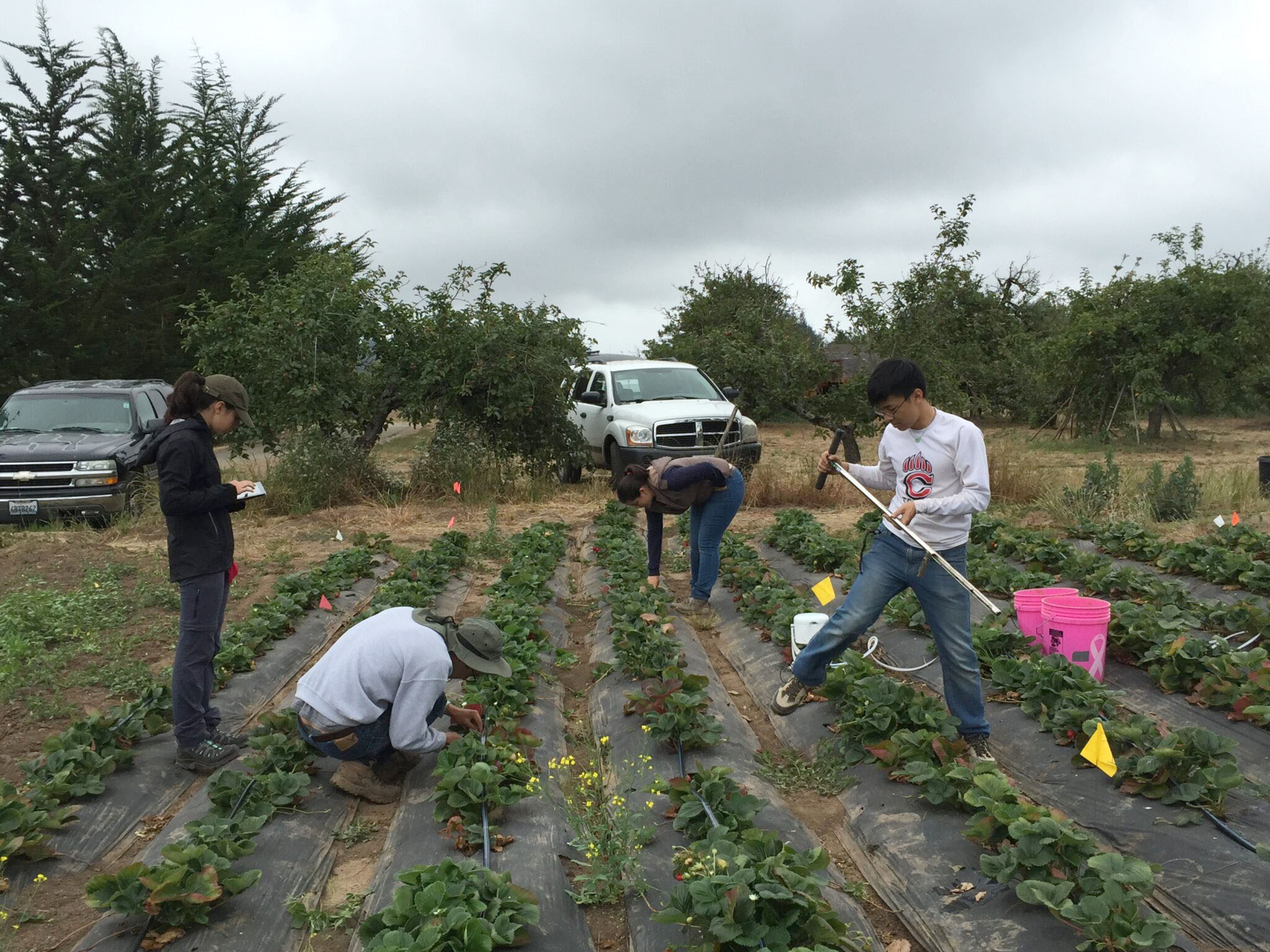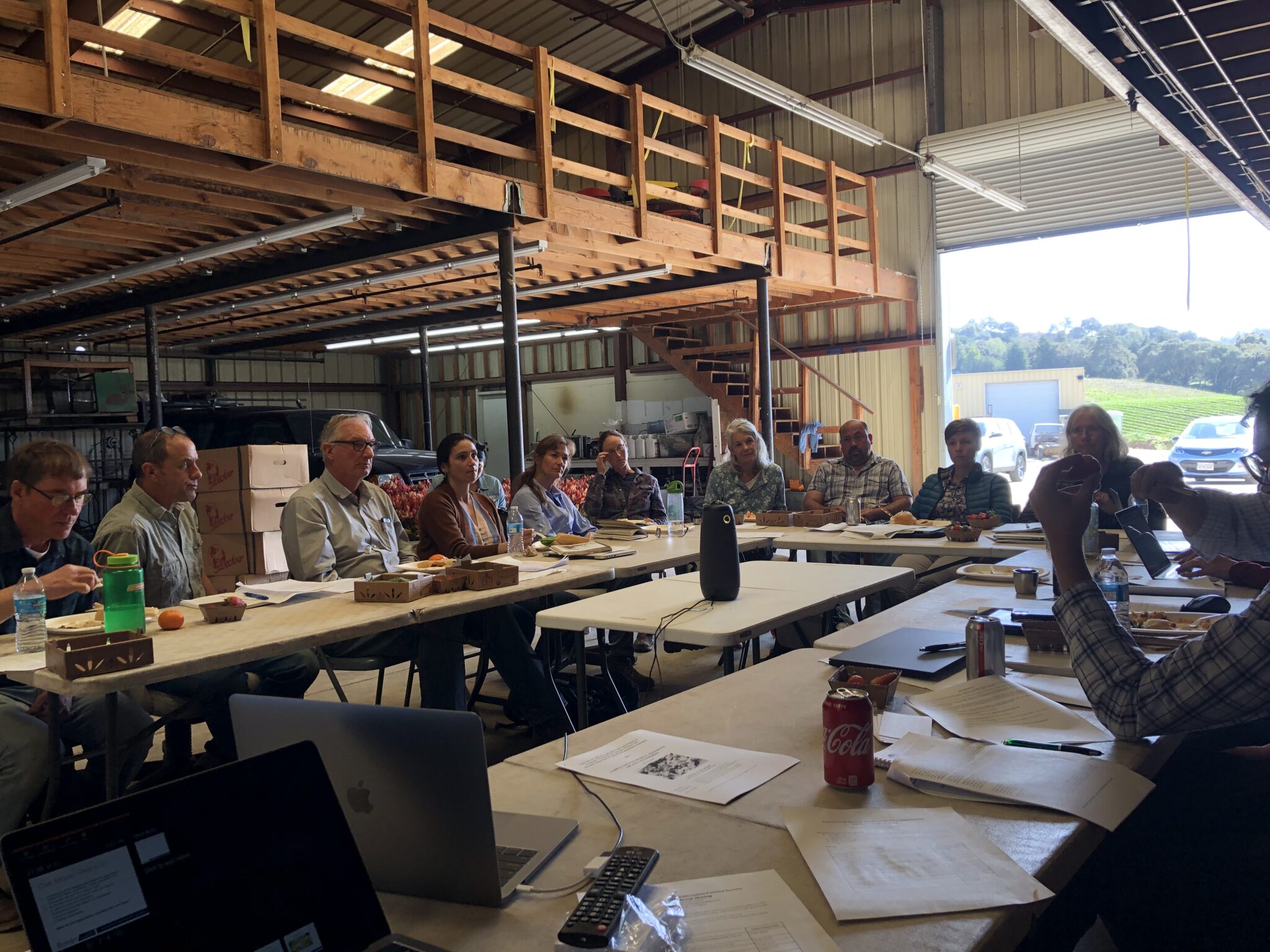From the Field
Joint Environmental and Social Benefits from Diversified Farming Systems: the Berkeley Backstory
A landmark study in Science recently presented a powerful argument in support of agricultural diversification. BFI’s founding Faculty Co-Director Claire Kremen tells the story of this research and the community of Berkeley researchers behind it.

It began with a 2008 email from Sibella Kraus, of SAGE, to a group of Berkeley faculty working on agriculture-related themes. In it, she asked, Would anyone like to apply for funding from the Berkeley Institute of the Environment to support interdisciplinary faculty roundtables at UC Berkeley?
It caught me at one of those pivotal moments. I had just been out conducting my fieldwork in Yolo County, where for some years I’d been studying pollinators and crop pollination on farms that varied from huge arrays of single crops regularly drenched in pesticides to much smaller farms planting a wide array of crops (e.g. 50 varieties of tomatoes alone, plus 50 other crops, and flowers, insectary strips, hedgerows), generally without the pesticides. It was amply clear from our data how the smaller diversified farms and the nearby natural landscapes supported native pollinators and introduced honey bees alike, resulting in much better crop pollination. These environments were also more aesthetically appealing and seemingly healthful for people.
This research made me wonder, naively I now see, why this farming style, which seemed superior in so many ways, was so rare within California’s farming region.
And so, I rose to Sibella’s bait and proposed to my colleagues an interdisciplinary roundtable on Diversified Farming Systems — to study its social and environmental benefits, costs, opportunities and barriers to adoption. In other words, if this type of farming is so great, why is it not more prevalent? We received the funds, hired Albie Miles (now Associate Professor of Sustainable Community Food Systems at University of Hawai’i-West O‘ahu) as our graduate student coordinator, and off we went.
Our early work as a research group resulted in an edited volume of Ecology and Society (Vol 17(4), 2012), in which we defined what is a “diversified farming system” and reviewed what was then known of those environmental and social benefits, costs, opportunities and barriers to adoption.
One person who came to our roundtable meetings, although he was not working on agriculture at that point and wasn’t therefore part of the original email chain, was social scientist Professor Alastair Iles. He and I had never previously ‘talked,’ but at an ESPM Faculty lunch I had the good fortune of sitting next to him, and we embarked on a lengthy discussion about diversified farming systems scribbled on the backs of numerous pieces of paper. Of all the faculty involved in the roundtable, he emerged as the most devoted partner, and we worked together subsequently to write the lead article for the Ecology and Society volume, edit the other articles, and ultimately, establish the Center for Diversified Farming Systems (from which grew the Berkeley Food Institute, which we also co-led as Founding Faculty Co-Directors, but that is another long story).
After the Ecology and Society volume, the next step was to start researching diversified farming systems in a way that encompassed a much broader purview than previous work. Much of that work, including my own, evaluated a single diversification practice, such as adding native plant hedgerows, and compared it against the simplified situation (i.e. no hedgerows). But on real farms, the number and type of diversification practices vary greatly. Further, most prior work evaluated only the effect on a single ecological or social process, though our review work clearly showed that most diversification practices affected multiple processes, both in synergies and tradeoffs.
Adding hedgerows, for example, provides habitat for both pollinators and also other beneficial organisms like birds, spiders and other arthropods that control crop pests, resulting in both pollination and pest control. Hedgerows also help to reduce erosion from wind and rain and store carbon. However, they can shade crops, resulting in lower yields, and planting them increases labor costs. Thus, it was important to study multiple environmental and social processes on real farms that vary in the number and type of diversification practices on the farm and in the surrounding landscape, although such a design is complex to set up and difficult to interpret.
Through several courses and further development of the Center for Diversified Farming Systems — stimulated in large part by then graduate students Liz Carlisle (now Assistant Professor at UC Santa Barbara), Maywa Montenegro (now Assistant Professor at UC Santa Cruz) and Lauren Ponisio (now Assistant Professor at University of Oregon) — we continued to expand the interdisciplinary and systems-oriented approaches to this work.
The next step was to gather a subgroup of faculty, postdocs and students to plan an empirical social-ecological study and find funding. After getting a grant from the USDA in 2015, we began our work in Monterey and Santa Cruz counties, using strawberry as our focal crop. Sociologist Professor Kathryn De Master and soil scientist Professor Celine Pallud joined the effort, along with then postdocs David Gonthier (now Assistant Professor at University of Kentucky), Danny Karp (now Associate Professor at UC Davis) and Amber Sciligo (now Director of Science Programs at The Organic Center) and then graduate students Adrian Lu, Patrick Baur (now Assistant Professor at University of Rhode Island) and Aidee Guzman (soon-to-be Assistant Professor at Stanford University).

Organic growers and representatives from the USDA and local conservation districts meet with researchers from the Center for Diversified Farming Systems to discuss implications and design of their research. Photo by Tim Bowles

Hannah Waterhouse, a former postdoc in the Berkeley Agroecology Lab and now Professor of Agroecology and Watershed Ecology at UC Santa Cruz, collects soil samples at a lettuce form. Photo by Kait Libbey
We started work on about 20 farms, all organic but varying from monocultures of only strawberry with none or few diversification practices to polycultures of many crops and diversification strategies. We crossed this “farm-scale” diversification gradient with a “landscape-scale” gradient in natural and semi-natural habitat surrounding each farm – such that we had simplified and diversified farms occurring in both simplified (low natural habitat) and complex (high natural habitat) landscapes. Overall, we found that complex interplays of the farm-scale diversification and the surrounding landscape complexity influenced patterns of bird and arthropod diversity and the pest control services these organisms provide.
A huge issue that kept coming up in farmer interviews was how farmers in this region were buffeted by competing environmental regulations and pressure from supply chains. On the one hand, farmers had to pay attention to food safety regulators that warned them to get rid of any features that might attract wildlife vectors of diseases, while on the other hand, they had to stay on the right side of water quality and endangered species regulations that would require keeping such features. Competing policies were one of the factors preventing farmers from adopting diversification practices in the first place, and sometimes caused them to remove hedgerows or other features that they’d implemented under different policies years before.
In response to these concerns, work of this group, which now came under the leadership of then new Professor Tim Bowles (now BFI’s Co-Associate Faculty Director), moved to focus on organic lettuce production and how tensions between water quality and food safety — concerns that dominate that industry — might be addressed by diversified farming systems that support soil health and biodiversity.
Meanwhile, some 900 miles north in Vancouver, Canada, Professor Hannah Wittman and colleagues at the University of British Columbia started a similar interdisciplinary collaboration, the Diversified Agroecosystem Research Cluster. In 2018, they invited me to join a workshop where I met Zia Mehrabi (then a postdoc with Wittman and now an Assistant Professor at CU Boulder), and we hatched the plan to look for other studies around the globe that, like our California study system, had investigated both social and environmental outcomes along gradients of agricultural diversification.
After identifying a good number of such studies, we made a successful bid to the NSF-funded National Social-Environmental Synthesis Center (SESYNC) to conduct a “quantitative synthesis” that would bring together the data from all of these studies within a common analysis framework, in order to see what we could learn across studies and regions that was generalizable.
From the analysis of 2,655 farms from 11 countries and 24 studies, our team of over 50 authors (including many from the California strawberry study) discovered some amazing patterns that were not apparent from the individual studies alone. Specifically, we found that farmers that adopted either more diversification practices, or more different strategies of diversification (such as techniques that increase crop diversity versus techniques that increase non-crop diversity), achieved greater environmental and social benefits, both singly and jointly. This finding, published recently in Science, is a powerful argument in support of agricultural diversification.
Looking back at Sibella’s first email, which led to the Roundtable on Diversified Farming Systems and the series of reviews we produced in Ecology and Society — and then to much subsequent work around the globe on diversified farming systems — it’s clear that this work has been influential, stimulating not only our own complex field studies in California and the SESYNC synthesis, but also so many other studies and ways of looking at these problems. Collectively, the academic community working on these problems around the globe are getting closer to understanding the benefits, costs, opportunities, and barriers to adoption of diversified farming systems, and hopefully one day, these results will bear fruit in altering policies to promote a more sustainable future.